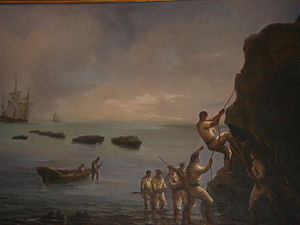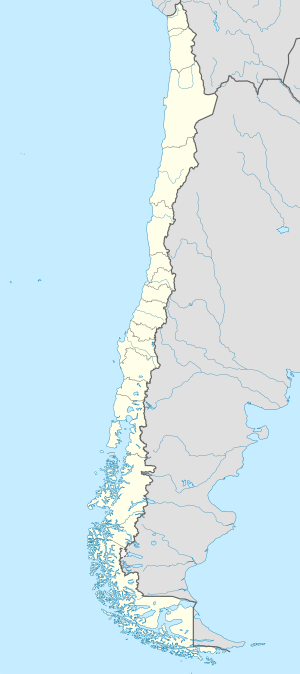
Corral is a town, commune, and sea port in Valdivia Province, Los Ríos Region, Chile. It is located south of Corral Bay. During the colonial period, Corral was the headquarters of the Valdivian Fort System, which protected Valdivia. Economic activities in Corral revolve around forestry, aquaculture, fishing, port services and both heritage, and eco tourism.

Valdivia is a city and commune in southern Chile, administered by the Municipality of Valdivia. The city is named after its founder, Pedro de Valdivia, and is located at the confluence of the Calle-Calle, Valdivia, and Cau-Cau Rivers, approximately 15 km (9 mi) east of the coastal towns of Corral and Niebla. Since October 2007, Valdivia has been the capital of Los Ríos Region and is also the capital of Valdivia Province. The national census of 2017 recorded the commune of Valdivia as having 166,080 inhabitants (Valdivianos), of whom 150,048 were living in the city. The main economic activities of Valdivia include tourism, wood pulp manufacturing, forestry, metallurgy, and beer production. The city is also the home of the Austral University of Chile, founded in 1954 and the Centro de Estudios Científicos.
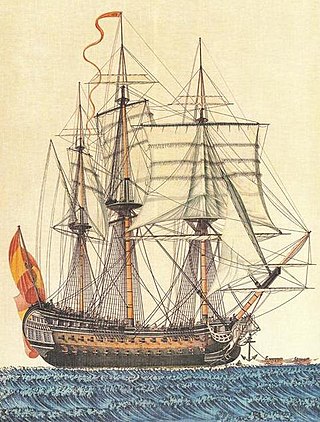
San Telmo was a Spanish 74-gun ship of the line, launched in 1788. It sank in 1819, while bringing reinforcements to Peru during the war of independence. Based on the location where it was lost, it has been speculated that survivors may have reached Antarctica.

The Chilean War of Independence was a military and political event that allowed the emancipation of Chile from the Spanish Monarchy, ending the colonial period and initiating the formation of an independent republic.

Mancera Island is a minor island at the mouth of Valdivia River in Corral Bay.
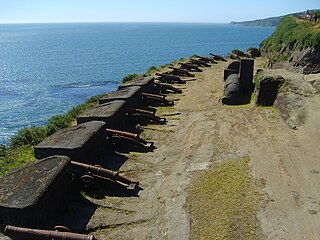
The Fort System of Valdivia is a series of Spanish colonial fortifications at Corral Bay, Valdivia and Cruces River established to protect the city of Valdivia, in southern Chile. During the period of Spanish rule (1645–1820), it was one of the biggest systems of fortification in the Americas. It was also a major supply source for Spanish ships that crossed the Strait of Magellan.

Niebla is a coastal Chilean town close to the city of Valdivia, Valdivia Province, Los Ríos Region. Niebla is located on the northern edge, at the mouth of the Valdivia River, across from Corral. Niebla's beach and folk market are popular tourist destinations during the summer, together with the ruins of a Spanish colonial fort and its museum.

The Battle of El Toro was fought near Maullín, Chile between Chilean patriots and Spanish royalists, during the Chilean War of Independence.
Valdivia is one of the few cities in southern Chile with a more less continuous and well documented history from its foundation in the 16th century onwards.

The Chilean Declaration of Independence is a document declaring the independence of Chile from the Spanish Empire. It was drafted in January 1818 and approved by Supreme Director Bernardo O'Higgins on 12 February 1818 at Talca, despite being dated in Concepción on 1 January 1818. The ceremony of independence was performed on 12 February 1818, the first anniversary of the Battle of Chacabuco.

New Fatherland was a period in the history of Chile that began with the victory of Ejército de los Andes in the Battle of Chacabuco on 12 February 1817 and ended with the resignation of Bernardo O'Higgins as Supreme Director in 1823.

Jorge Beauchef was a French military who participated in the Napoleonic Wars. He is best known in Latin America for his participation in the Chilean War of Independence, where he won many battles. This first battle, one of the most famous, ensured Chile's independence, putting an end to the continuous Spanish domination since 1536.

The First Chilean Navy Squadron was the heterogeneous naval force that terminated Spanish colonial rule in the Pacific and protagonized the most important naval actions of in the Latin American wars of independence. The Chilean revolutionary government organized the squadron in order to carry the war to the Viceroyalty of Perú, then the center of Spanish power in South America, and thus secure the independence of Chile and Argentina.
Independencia was a 26-gun corvette of the First Chilean Navy Squadron.

Manuel Olaguer Feliú was a Spanish military engineer known for his role in constructing and overhauling fortifications in Colonial Chile as well as his later participation in the Chilean and Peruvian wars of independence. Upon his return to metropolitan Spain he was promoted to the rank Field Marshal and became Captain General of Galicia.

The Dutch expedition to Valdivia was a naval expedition, commanded by Hendrik Brouwer, sent by the Dutch Republic in 1643 to establish a base of operations and a trading post on the southern coast of Chile. With Spain and the Dutch Republic at war, the Dutch wished to take over the ruins of the abandoned Spanish city of Valdivia. The expedition sacked the Spanish settlements of Carelmapu and Castro in the Chiloé Archipelago before sailing to Valdivia, having the initial support of the local natives. The Dutch arrived in Valdivia on 24 August 1643 and named the colony Brouwershaven after Brouwer, who had died several weeks earlier. The short-lived colony was abandoned on 28 October 1643. Nevertheless, the occupation caused great alarm among Spanish authorities. The Spanish resettled Valdivia and began the construction of an extensive network of fortifications in 1645 to prevent a similar intrusion. Although contemporaries considered the possibility of a new incursion, the expedition was the last one undertaken by the Dutch on the west coast of the Americas.
In Colonial times the Spanish Empire diverted significant resources to fortify the Chilean coast as a consequence of Dutch and English raids. During the 16th century the Spanish strategy was to complement the fortification work in its Caribbean ports with forts in the Strait of Magellan. As attempts at settling and fortifying the Strait of Magellan were abandoned the Spanish began to fortify the Captaincy General of Chile and other parts of the west coast of the Americas. The coastal fortifications and defense system was at its peak in the mid-18th century.

Morro Gonzalo is a steep hill and northward headland marking the western limit of Corral Bay in Chile. During colonial times it hosted an observation post and a cannon of 4 pounds which was part of the Valdivian Fort System. There is a South American sea lion colony at the base of Morro Gonzalo. In 1996 there were 34 sea lions, of which about 15 where adult males, 10 were females and 10 were juveniles.
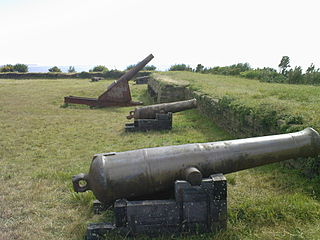
Agüi Fort, also written as Agui or Ahui, and otherwise known as San Miguel de Agüi Castle), is a fortification located on the Lacuy peninsula, Chile.

By the late 1660s, the English rulers had considered invading Spanish-ruled Chile for several years. In 1655, Simón de Casseres proposed to Oliver Cromwell a plan to take over Chile with only four ships and a thousand men.
